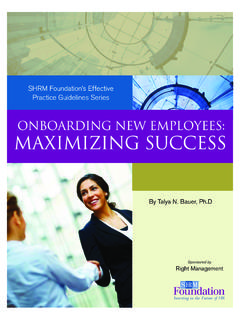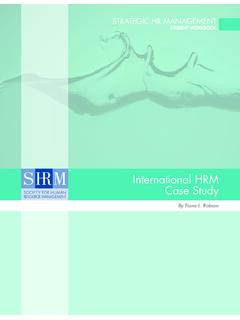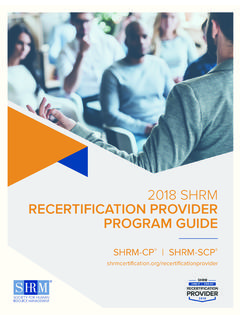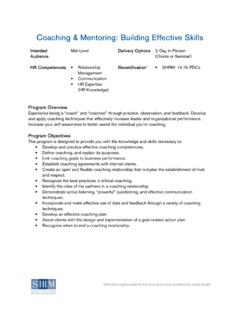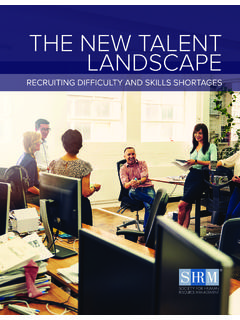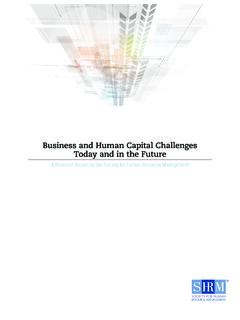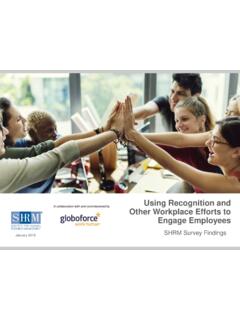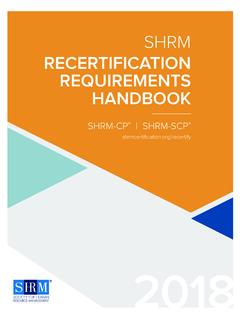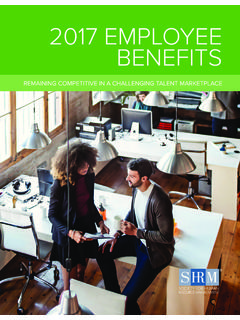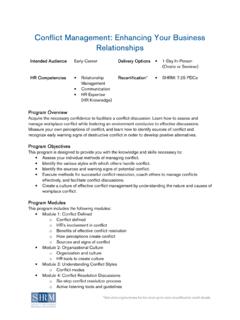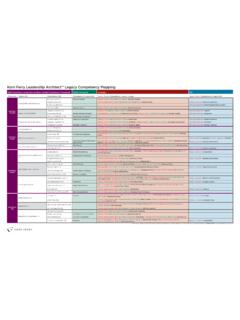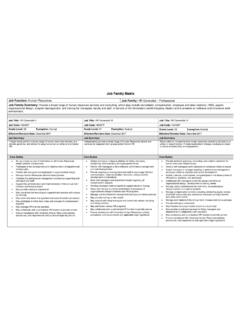Transcription of THE SHRM BODY OF COMPETENCY AND KNOWLEDGE™
1 THE SHRM BODY. OF COMPETENCY . AND KNOWLEDGE . shrmcerti TABLE OF CONTENTS. Introduction to the SHRM Body of COMPETENCY and 1. What Are Competencies?.. 3. Development of the SHRM New Material in the 2017 6. Organization of the SHRM BoCK Section 1: Behavioral Section 2: HR Section 1: Behavioral 8. How to Read This 8. leadership 11. leadership & 12. Ethical 14. Interpersonal 17. Relationship 20. Global & Cultural Business Business Critical Section 2: HR 32. How to Read This 32. People Knowledge Functional Area #1: HR Strategic Functional Area #2: Talent Functional Area #3: Employee Engagement & Functional Area #4: Learning & 41. Functional Area #5: Total 42. Organization Knowledge Functional Area #6: Structure of the HR 44. Functional Area #7: Organizational Effectiveness & Development ..45. Functional Area #8: Workforce Functional Area #9: Employee & Labor 47. Functional Area #10: Technology Workplace Knowledge Functional Area #11: HR in the Global Functional Area #12: Diversity & Functional Area #13: Risk Functional Area #14: Corporate Social Functional Area #15: Employment Law & 57.
2 Appendix A: 59. Appendix B: 69. THE SHRM BODY OF COMPETENCY . SECTION AND COMPETENCIES. 1: BEHAVIORAL KNOWLEDGE. Introduction to the SHRM Body of COMPETENCY and Knowledge . For more than sixty- ve years, the Society for The SHRM Body of COMPETENCY and Knowledge . Human Resource Management (SHRM) has (SHRM BoCK ), which is based on the SHRM. served the human resources (HR) profession. COMPETENCY Model and illustrated in Figure 1, HR professionals worldwide look to SHRM for outlines the content of SHRM's certification comprehensive information and tools to help examinations, the SHRM Certified Professional them perform effectively at their jobs, to develop (SHRM-CP ) exam for early-career and mid-level their careers, and to partner strategically with practitioners, and the SHRM Senior Certified employers. SHRM also works to advance the HR Professional (SHRM-SCP ) exam for senior-level profession as a whole, ensuring that as business and executive practitioners.
3 SHRM credentials changes, HR evolves to meet business needs. provide reliable indicators to the global business Increasingly, business leaders understand that community that the credential holder has the effective people management is a strategic necessary capabilities in both aspects of HR. imperative. As a result, employers expect HR practice competencies and knowledge that professionals to demonstrate, in addition to are required for effective job performance. a thorough knowledge of HR concepts and requirements, the behavioral competencies In addition to describing the behavioral required to effectively apply that knowledge competencies and technical knowledge tested in the modern workplace in support of on the SHRM-CP and SHRM-SCP certification organizational goals. exams, the SHRM BoCK is also the common framework for individuals developing exam In 2011, SHRM began a program of research questions (item writers), as well as individuals involving thousands of HR professionals to and organizations developing exam preparation identify the critical competencies needed for materials.
4 SHRM's own operations for exam success as an HR professional. This research led development are separate and independent from to the development of the SHRM COMPETENCY its operations for study material development. Model, which defines eight key behavioral SHRM observes a strict firewall between these competencies (Ethical Practice, leadership & activities to protect the integrity and credibility of Navigation, Business acumen , Relationship the certification exams. Management, Communication, Consultation, Critical Evaluation and Global & Cultural Effectiveness) and one technical COMPETENCY (HR Expertise). The SHRM COMPETENCY Model provides HR professionals with a comprehensive roadmap for developing the capabilities they need to advance their careers and improve their effectiveness in the workplace. THE SHRM BODY OF COMPETENCY AND KNOWLEDGE 1. THE SHRM BODY. BODY OF. OF COMPETENCY . COMPETENCYAND. ANDKNOWLEDGE. KNOWLEDGE. FIGURE 1: SHRM Body of COMPETENCY and Knowledge (SHRM BoCK).
5 2 THE SHRM BODY OF COMPETENCY AND KNOWLEDGE. INTRODUCTION. What Are Competencies? A COMPETENCY is a group of highly interrelated knowledge, skills, abilities and other characteristics (KSAOs) that give rise to the behaviors needed to perform a given job effectively. For example, Critical Evaluation, one of the behavioral competencies in the SHRM COMPETENCY Model, describes a group of KSAOs that include knowledge of research design, critical thinking skills and deductive reasoning abilities. These highly interrelated KSAOs enable HR professionals to collect, compile, analyze and interpret job-relevant data and information for the purpose of supporting the HR function in their organizations. A set of competencies that collectively defines the requirements for effective performance in a specific job, profession or organization may be called a COMPETENCY model. Competencies can be either technical or behavioral. Technical competencies reflect the knowledge specific to a given profession that is required for a professional in that field to perform a particular role.
6 The HR Expertise COMPETENCY in the SHRM COMPETENCY Model describes the technical knowledge specific to the HR field (such as that associated with talent management, recruiting, or compensation and benefits). Behavioral competencies, on the other hand, describe the KSAOs that facilitate the application of technical knowledge to job-related behaviors. They are more general in their applicability than the profession-specific technical COMPETENCY of HR Expertise. For example, the behavioral COMPETENCY Communication describes the KSAOs needed to effectively communicate across a range of media ( , e-mail and oral presentations) and with a variety of audiences ( , internal and external stakeholders). In sum, technical competencies reflect what knowledge HR professionals apply to their jobs, and behavioral competencies reflect how they apply this knowledge. Knowledge + Behavior = Success SHRM's incorporation of behavioral and technical employers and universities, described below, found competencies into its COMPETENCY model and that both HR knowledge and behavior are related to certification exams implicitly recognizes that a strategic HR professionals' job performance.
7 Moreover, it found mindset leading to HR success is a function of the that both knowledge and behavior are uniquely related successful application of both knowledge and behavior. to job performance that is, knowledge and behavior In other words, success stems not only from what you are related to job performance in non-redundant know (knowledge) but also what you do (behavior). ways. These findings support the key contributions of Neither is sufficient, however, in isolation. knowledge and behavior to HR success, the relevance and applicability of the SHRM COMPETENCY Model to SHRM's dual approach to understanding HR success is the HR profession, and the relevance of certification supported by empirical research. A study conducted by exams that test both behavioral and technical SHRM in partnership with several leading multinational competencies. THE SHRM BODY OF COMPETENCY AND KNOWLEDGE 3. THE SHRM BODY OF COMPETENCY AND KNOWLEDGE. Development of the SHRM BoCK.
8 SHRM has been engaged in a systematic and COMPETENCY Model. The results of this study rigorous program of research to develop the provided support for the relevance of the model SHRM BoCK, as outlined in Figure 2. SHRM in describing the personal and professional began this program with the development of attributes needed for HR success, as well as its the SHRM COMPETENCY Model in 2011, and it wide applicability. SHRM next conducted (also in continued through 2016 by conducting a Practice 2012) a multi-organizational criterion validation study, Analysis to further develop and refine the BoCK. involving a highly diverse sample of more than 800. Comprehensive job analysis methods and the HR professionals and their supervisors, to measure active engagement of the global HR community the link between the COMPETENCY model and job have been used consistently to identify, create and performance. The results of this study established refine competencies that describe the attributes that proficiency in the SHRM-defined competencies necessary for success as an HR professional.
9 Is closely linked to successful job performance. Development of the SHRM COMPETENCY Model was In 2014, SHRM conducted a knowledge initiated in 2011, when SHRM conducted 111 focus specification exercise to further develop the HR. groups with nearly 1,200 HR practitioners, including Expertise technical COMPETENCY in particular. First, professionals from 33 countries. Participants in SHRM performed an extensive review of the these focus groups represented a diversity of existing literature on HR knowledge, including characteristics, both personal ( , career level, textbooks, curricula, syllabi and other educator tenure) and organizational ( , sector, industry, resources, to determine the universe of potential size). SHRM also conducted a survey of more than areas of knowledge that HR professionals need to 600 Chief Human Resources Officers (CHROs) to perform their jobs. SHRM also consulted its own identify the competencies that HR leaders believe academic and employer surveys regarding the are required for success in the HR profession.
10 Functional knowledge that HR professionals need Following this extensive data collection, SHRM to achieve success in the HR field. SHRM drew on created a working COMPETENCY model of eight this research to create a preliminary knowledge behavioral competencies and one technical framework for the SHRM-CP and SHRM-SCP exams. (knowledge-based) COMPETENCY , which together describe the personal and professional attributes Second, SHRM established in 2014 a BoCK Advisory that HR professionals need for success and career Panel of 19 HR and business leaders from various advancement. industries, including retail, research, consulting, health care and manufacturing. This panel reviewed From 2012 to 2014, SHRM conducted a series of the proposed content and framework of the HR. studies with HR professionals to confirm the content Expertise COMPETENCY to ensure its accuracy and of the model and its relevance to HR professional comprehensiveness. The panel also defined, for success.
